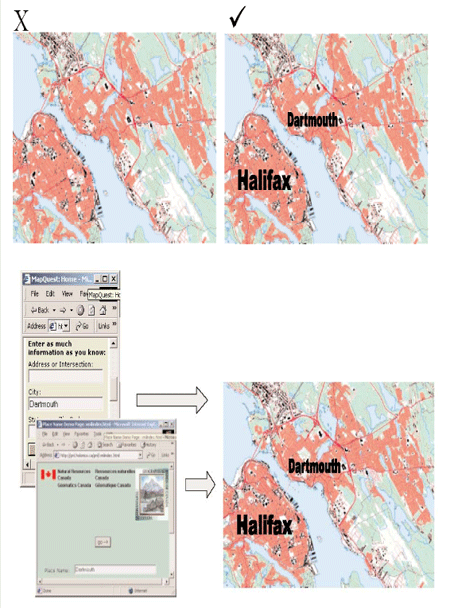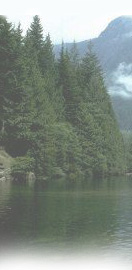Proactive disclosure
Print version   |  | 
Natural Resources Canada > Earth Sciences Sector > Priorities (2002-2006) > Geomatics for sustainable development of natural resources
Success Stories GeoNames Applications Releases GNApp for CGNS This information represents activities in the Earth Sciences Sector Programs (2002-2006). Please refer to Priorities for information on current Earth Sciences Sector Programs.
|
GSDNR's GeoNames Applications project officially released the GNApp component of the Canadian Geographical Names Service (CGNS), in September 2004. The GNApp component allows the GNBC members to directly maintain the CGNS data warehouse using a web application. The release of this latest component completes the CGNS, making it a comprehensive web based system for collecting, storing, maintaining, and distributing current and reliable
information about Canada's geographical names.
Partners may already begin uploading names into the GNApp application. In fact, the provinces of Newfoundland, Manitoba and Saskatchewan have already begun uploading names using the web-based interface.
Records of official geographical names have been maintained for over 100 years as part of the Geographical Names Board of Canada (GNBC)'s mandate to provide official toponymic information and advice to individuals and groups in and out of Canada. The upkeep and distribution of these records has evolved, however, to accommodate technological change and to increase the accessibility and utility of these records to groups and organizations.
In its earlier form, the Canadian Geographical Names Data Base (CGNDB) was distributed using file-based exchange mechanisms and database links. In this system, data was delivered as a file and had to be loaded into a local database in order to be used - a costly proposition for large organizations and virtually impossible for smaller ones or individuals. Additionally, in the previous system, data updates could only be made to a central file from which other files were duplicated for distribution. Organizations that obtained an initial set of data had to acquire update packages to maintain accurate information. These update packages were available on a quarterly basis, but were often not applied consistently since it was easier for users to update their own data sets directly on an as-required basis.
|
|
Toponymy in Canada
In Canada, Toponymy, or the discipline of recording place and feature names (for
example, names of rivers, lakes, mountains etc.), is the responsibility of the
Geographical Names Board of Canada (GNBC). Established in 1897, the GNBC is the federal,
provincial, and territorial body that coordinates the approval and documentation of
geographical names and compiles them into a central catalogue known as the Canadian Geographical Names Data Base (CGNDB). |
Advantages of the CGNS |
| • |
The CGNS is a free ondemand service that provides an immediate response to the user. |
| • |
Data provided through the CGNS is always complete and accurate. |
| • |
The need for independent updates that can be inconsistently applied is eliminated. |
| • |
Data is now available to smaller organizations and to individuals that could not
previously access this information because of the prohibitive costs of independent databases that were required to interpret the information. |
| • |
The CGNS allows national geographical names systems to run on data that is more complete and accurate at a lower cost. |
| • |
The CGNS permits better sharing of Canada's geographical names - a publicly-owned resource. |
|
|

As a next generation technonogical aid in the collection and distribution of reliable and accurate geographical names information, the CGNS overcomes these distribution challenges. First, the CGNS is web-based, meaning that it is accessible from anywhere that has an Internet connection. Also, because it is web based, a local database is not needed. By contrast, the CGNS conforms to an international standard making this distributed database accessible from a single web page. This means that Canada's geographical names are accessible to a greater number of countries, organizations and individuals. Secondly, data updates in this new system are made to the database through a web browser so that information that is distributed is always complete and accurate at the time of publication. In this way, updates are consistently applied.
The CGNS provides a names layer for digital maps and associates geographical names to places in digital format, making it useful for several applications including:
- Navigation in web-mapping applications, so that navigation can occur based on place names. For example, "Halifax" could become a target location that is found either manually or using a search operation based on geographical names;
- Resource tracking and business geographics geared towards sustainable development, so that the use and occurrence of natural resources can be traced according to geographical patterns through structured data that is linked to maps via place names. For example, city, forest clearcut, and success of revegetation could be compared and represented
geographically;
- Spatial searching, sorting, and reporting, so that web content can be searched based on a geographical area or by feature type (rivers, lakes, mountains, etc.). For example, a bioinformatics application could trace the incidence of SARS across the country or within a specific area using an Internet search engine.
|
|
For Developers
The CGNS is built on open architecture. Developers worldwide are encouraged to use the system when building their applications. The CGNS is compliant with the Open GIS Consortium standards for improved information sharing.
The system has an Application Programmatic Interface (API) to access the GNSS without using forms.
The GNSS User Interface can also respond to a referrer application.
More information regarding API parameters, code definitions, and information on how to use the refer functionality can be found in the GNSS on-line help file at:
http://gnss.nrcan.gc.ca/gnss-srt/help_api.jsp
Standard fittings allow a connection to be made with common software tools. E-mail the CGNS (cgns@nrcan.gc.ca) for information on how to make this connection directly for a
mapped view of the names, or for source data. |
|
Geographical Names and Sustainable Development
Geographical names describe the features of a land as well as
the culture and heritage of the people that live there. They
provide a reference to place, and help us define not only
where we are, but also who we are.
With respect to sustainable development, spatial data is used
to manage natural resources in the context of social,
environmental, and economic concerns.
Geographical names are an essential information layer of
any map used for this purpose, since they help us to orient
ourselves and allow us to situate one place in relation to
another. Geographical names provide the context from which
work towards sustainable development can be achieved.
|
Other Success Stories
GSDNR Communicator
|

